Analyzing Starbucks' Business Development in the South African Market
VerifiedAdded on 2023/06/04
|14
|3744
|316
Case Study
AI Summary
This case study examines Starbucks' entry and expansion into the South African market, highlighting the strategic drivers, competitive landscape, and future opportunities. It explores the South African consumer's spending habits, the growing middle class, and the globalization of retail brands as key factors influencing Starbucks' decision to enter the market. The analysis includes a Porter's Five Forces assessment, revealing moderate profitability and competitive intensity within the coffee retail industry. While Starbucks leverages its brand equity, scale, and fair trade practices for competitive advantage, challenges such as increasing prices and retail problems could hinder future expansion into other African markets. The study concludes by considering opportunities for growth in the African market amidst increasing coffee preference and a growing middle class, while also acknowledging potential obstacles to long-term success.

sheqere sefa
[COMPANY NAME] [Company address]
Starbucks in South Africa: A Strategic Move to Conquer the Continent?
Kela Sefa lon160114011
[COMPANY NAME] [Company address]
Starbucks in South Africa: A Strategic Move to Conquer the Continent?
Kela Sefa lon160114011
Paraphrase This Document
Need a fresh take? Get an instant paraphrase of this document with our AI Paraphraser
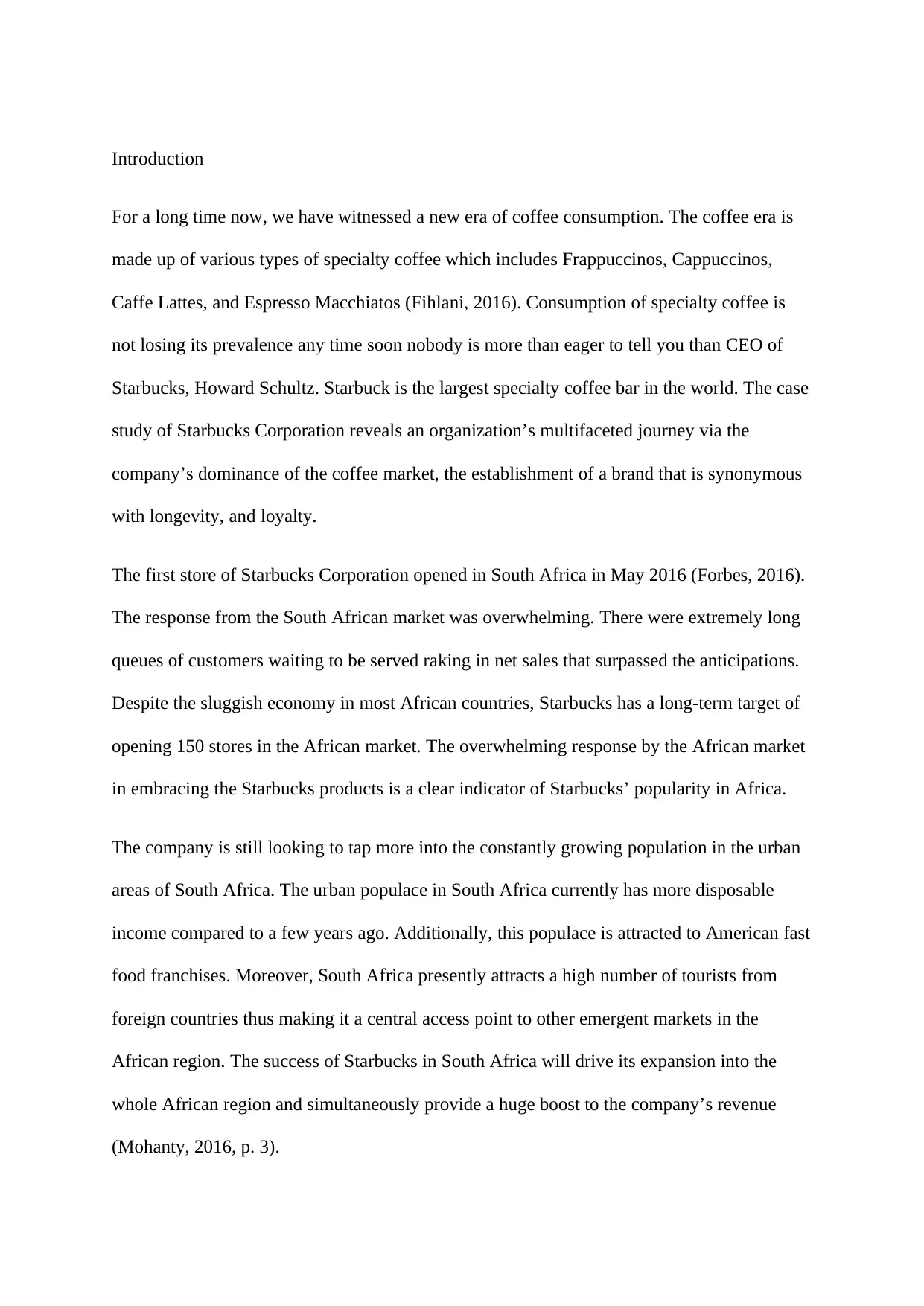
Introduction
For a long time now, we have witnessed a new era of coffee consumption. The coffee era is
made up of various types of specialty coffee which includes Frappuccinos, Cappuccinos,
Caffe Lattes, and Espresso Macchiatos (Fihlani, 2016). Consumption of specialty coffee is
not losing its prevalence any time soon nobody is more than eager to tell you than CEO of
Starbucks, Howard Schultz. Starbuck is the largest specialty coffee bar in the world. The case
study of Starbucks Corporation reveals an organization’s multifaceted journey via the
company’s dominance of the coffee market, the establishment of a brand that is synonymous
with longevity, and loyalty.
The first store of Starbucks Corporation opened in South Africa in May 2016 (Forbes, 2016).
The response from the South African market was overwhelming. There were extremely long
queues of customers waiting to be served raking in net sales that surpassed the anticipations.
Despite the sluggish economy in most African countries, Starbucks has a long-term target of
opening 150 stores in the African market. The overwhelming response by the African market
in embracing the Starbucks products is a clear indicator of Starbucks’ popularity in Africa.
The company is still looking to tap more into the constantly growing population in the urban
areas of South Africa. The urban populace in South Africa currently has more disposable
income compared to a few years ago. Additionally, this populace is attracted to American fast
food franchises. Moreover, South Africa presently attracts a high number of tourists from
foreign countries thus making it a central access point to other emergent markets in the
African region. The success of Starbucks in South Africa will drive its expansion into the
whole African region and simultaneously provide a huge boost to the company’s revenue
(Mohanty, 2016, p. 3).
For a long time now, we have witnessed a new era of coffee consumption. The coffee era is
made up of various types of specialty coffee which includes Frappuccinos, Cappuccinos,
Caffe Lattes, and Espresso Macchiatos (Fihlani, 2016). Consumption of specialty coffee is
not losing its prevalence any time soon nobody is more than eager to tell you than CEO of
Starbucks, Howard Schultz. Starbuck is the largest specialty coffee bar in the world. The case
study of Starbucks Corporation reveals an organization’s multifaceted journey via the
company’s dominance of the coffee market, the establishment of a brand that is synonymous
with longevity, and loyalty.
The first store of Starbucks Corporation opened in South Africa in May 2016 (Forbes, 2016).
The response from the South African market was overwhelming. There were extremely long
queues of customers waiting to be served raking in net sales that surpassed the anticipations.
Despite the sluggish economy in most African countries, Starbucks has a long-term target of
opening 150 stores in the African market. The overwhelming response by the African market
in embracing the Starbucks products is a clear indicator of Starbucks’ popularity in Africa.
The company is still looking to tap more into the constantly growing population in the urban
areas of South Africa. The urban populace in South Africa currently has more disposable
income compared to a few years ago. Additionally, this populace is attracted to American fast
food franchises. Moreover, South Africa presently attracts a high number of tourists from
foreign countries thus making it a central access point to other emergent markets in the
African region. The success of Starbucks in South Africa will drive its expansion into the
whole African region and simultaneously provide a huge boost to the company’s revenue
(Mohanty, 2016, p. 3).
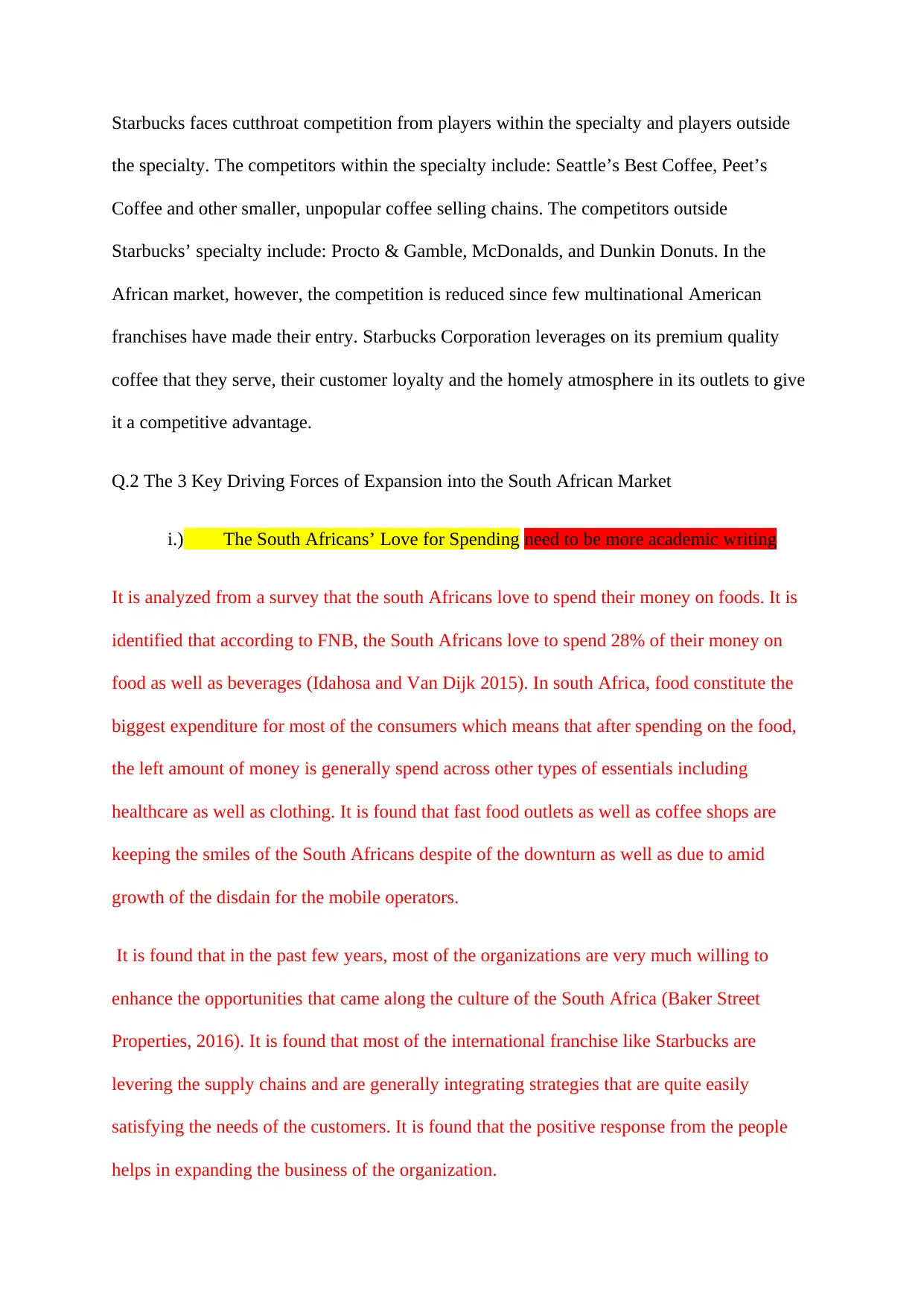
Starbucks faces cutthroat competition from players within the specialty and players outside
the specialty. The competitors within the specialty include: Seattle’s Best Coffee, Peet’s
Coffee and other smaller, unpopular coffee selling chains. The competitors outside
Starbucks’ specialty include: Procto & Gamble, McDonalds, and Dunkin Donuts. In the
African market, however, the competition is reduced since few multinational American
franchises have made their entry. Starbucks Corporation leverages on its premium quality
coffee that they serve, their customer loyalty and the homely atmosphere in its outlets to give
it a competitive advantage.
Q.2 The 3 Key Driving Forces of Expansion into the South African Market
i.) The South Africans’ Love for Spending need to be more academic writing
It is analyzed from a survey that the south Africans love to spend their money on foods. It is
identified that according to FNB, the South Africans love to spend 28% of their money on
food as well as beverages (Idahosa and Van Dijk 2015). In south Africa, food constitute the
biggest expenditure for most of the consumers which means that after spending on the food,
the left amount of money is generally spend across other types of essentials including
healthcare as well as clothing. It is found that fast food outlets as well as coffee shops are
keeping the smiles of the South Africans despite of the downturn as well as due to amid
growth of the disdain for the mobile operators.
It is found that in the past few years, most of the organizations are very much willing to
enhance the opportunities that came along the culture of the South Africa (Baker Street
Properties, 2016). It is found that most of the international franchise like Starbucks are
levering the supply chains and are generally integrating strategies that are quite easily
satisfying the needs of the customers. It is found that the positive response from the people
helps in expanding the business of the organization.
the specialty. The competitors within the specialty include: Seattle’s Best Coffee, Peet’s
Coffee and other smaller, unpopular coffee selling chains. The competitors outside
Starbucks’ specialty include: Procto & Gamble, McDonalds, and Dunkin Donuts. In the
African market, however, the competition is reduced since few multinational American
franchises have made their entry. Starbucks Corporation leverages on its premium quality
coffee that they serve, their customer loyalty and the homely atmosphere in its outlets to give
it a competitive advantage.
Q.2 The 3 Key Driving Forces of Expansion into the South African Market
i.) The South Africans’ Love for Spending need to be more academic writing
It is analyzed from a survey that the south Africans love to spend their money on foods. It is
identified that according to FNB, the South Africans love to spend 28% of their money on
food as well as beverages (Idahosa and Van Dijk 2015). In south Africa, food constitute the
biggest expenditure for most of the consumers which means that after spending on the food,
the left amount of money is generally spend across other types of essentials including
healthcare as well as clothing. It is found that fast food outlets as well as coffee shops are
keeping the smiles of the South Africans despite of the downturn as well as due to amid
growth of the disdain for the mobile operators.
It is found that in the past few years, most of the organizations are very much willing to
enhance the opportunities that came along the culture of the South Africa (Baker Street
Properties, 2016). It is found that most of the international franchise like Starbucks are
levering the supply chains and are generally integrating strategies that are quite easily
satisfying the needs of the customers. It is found that the positive response from the people
helps in expanding the business of the organization.
⊘ This is a preview!⊘
Do you want full access?
Subscribe today to unlock all pages.

Trusted by 1+ million students worldwide
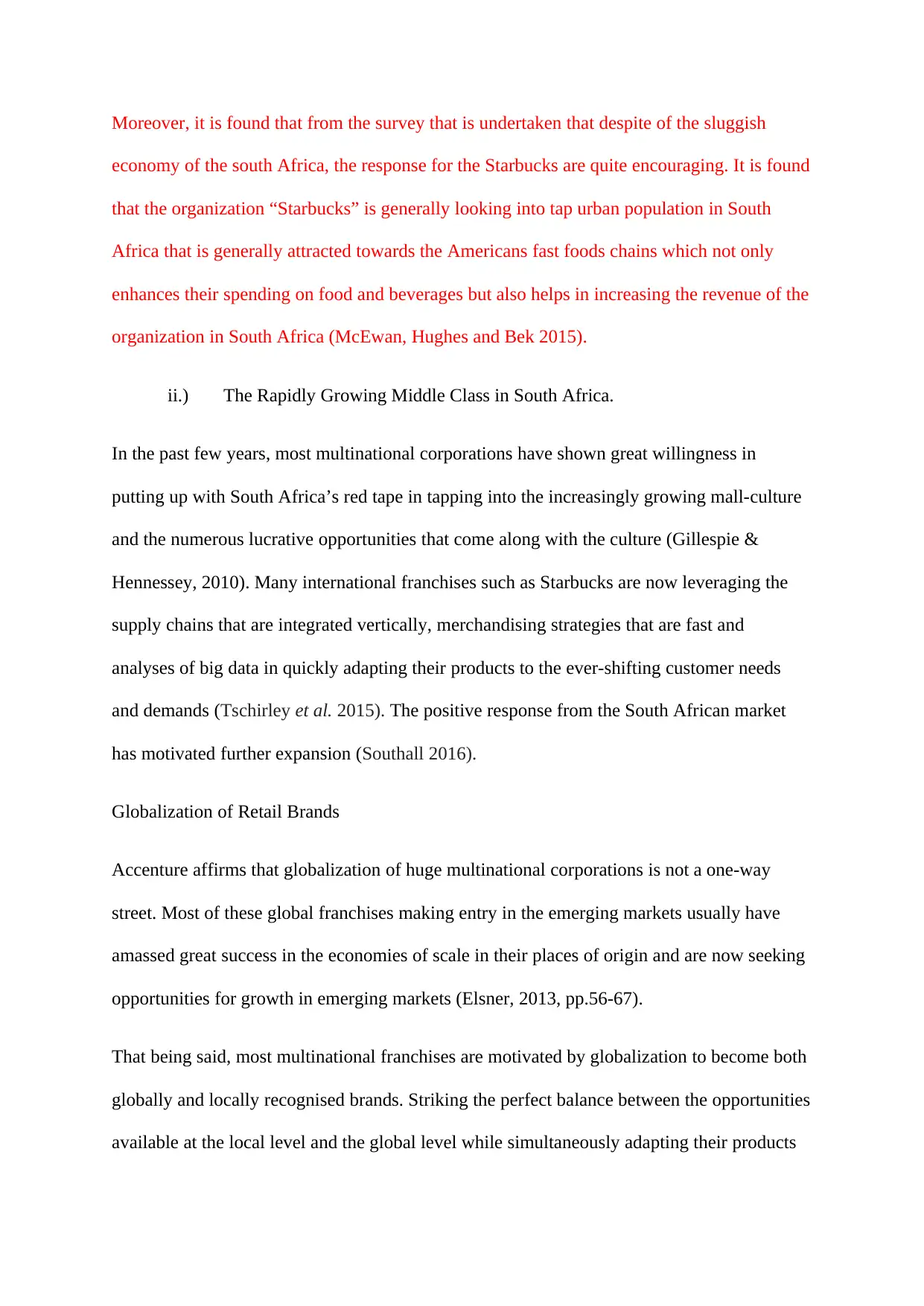
Moreover, it is found that from the survey that is undertaken that despite of the sluggish
economy of the south Africa, the response for the Starbucks are quite encouraging. It is found
that the organization “Starbucks” is generally looking into tap urban population in South
Africa that is generally attracted towards the Americans fast foods chains which not only
enhances their spending on food and beverages but also helps in increasing the revenue of the
organization in South Africa (McEwan, Hughes and Bek 2015).
ii.) The Rapidly Growing Middle Class in South Africa.
In the past few years, most multinational corporations have shown great willingness in
putting up with South Africa’s red tape in tapping into the increasingly growing mall-culture
and the numerous lucrative opportunities that come along with the culture (Gillespie &
Hennessey, 2010). Many international franchises such as Starbucks are now leveraging the
supply chains that are integrated vertically, merchandising strategies that are fast and
analyses of big data in quickly adapting their products to the ever-shifting customer needs
and demands (Tschirley et al. 2015). The positive response from the South African market
has motivated further expansion (Southall 2016).
Globalization of Retail Brands
Accenture affirms that globalization of huge multinational corporations is not a one-way
street. Most of these global franchises making entry in the emerging markets usually have
amassed great success in the economies of scale in their places of origin and are now seeking
opportunities for growth in emerging markets (Elsner, 2013, pp.56-67).
That being said, most multinational franchises are motivated by globalization to become both
globally and locally recognised brands. Striking the perfect balance between the opportunities
available at the local level and the global level while simultaneously adapting their products
economy of the south Africa, the response for the Starbucks are quite encouraging. It is found
that the organization “Starbucks” is generally looking into tap urban population in South
Africa that is generally attracted towards the Americans fast foods chains which not only
enhances their spending on food and beverages but also helps in increasing the revenue of the
organization in South Africa (McEwan, Hughes and Bek 2015).
ii.) The Rapidly Growing Middle Class in South Africa.
In the past few years, most multinational corporations have shown great willingness in
putting up with South Africa’s red tape in tapping into the increasingly growing mall-culture
and the numerous lucrative opportunities that come along with the culture (Gillespie &
Hennessey, 2010). Many international franchises such as Starbucks are now leveraging the
supply chains that are integrated vertically, merchandising strategies that are fast and
analyses of big data in quickly adapting their products to the ever-shifting customer needs
and demands (Tschirley et al. 2015). The positive response from the South African market
has motivated further expansion (Southall 2016).
Globalization of Retail Brands
Accenture affirms that globalization of huge multinational corporations is not a one-way
street. Most of these global franchises making entry in the emerging markets usually have
amassed great success in the economies of scale in their places of origin and are now seeking
opportunities for growth in emerging markets (Elsner, 2013, pp.56-67).
That being said, most multinational franchises are motivated by globalization to become both
globally and locally recognised brands. Striking the perfect balance between the opportunities
available at the local level and the global level while simultaneously adapting their products
Paraphrase This Document
Need a fresh take? Get an instant paraphrase of this document with our AI Paraphraser
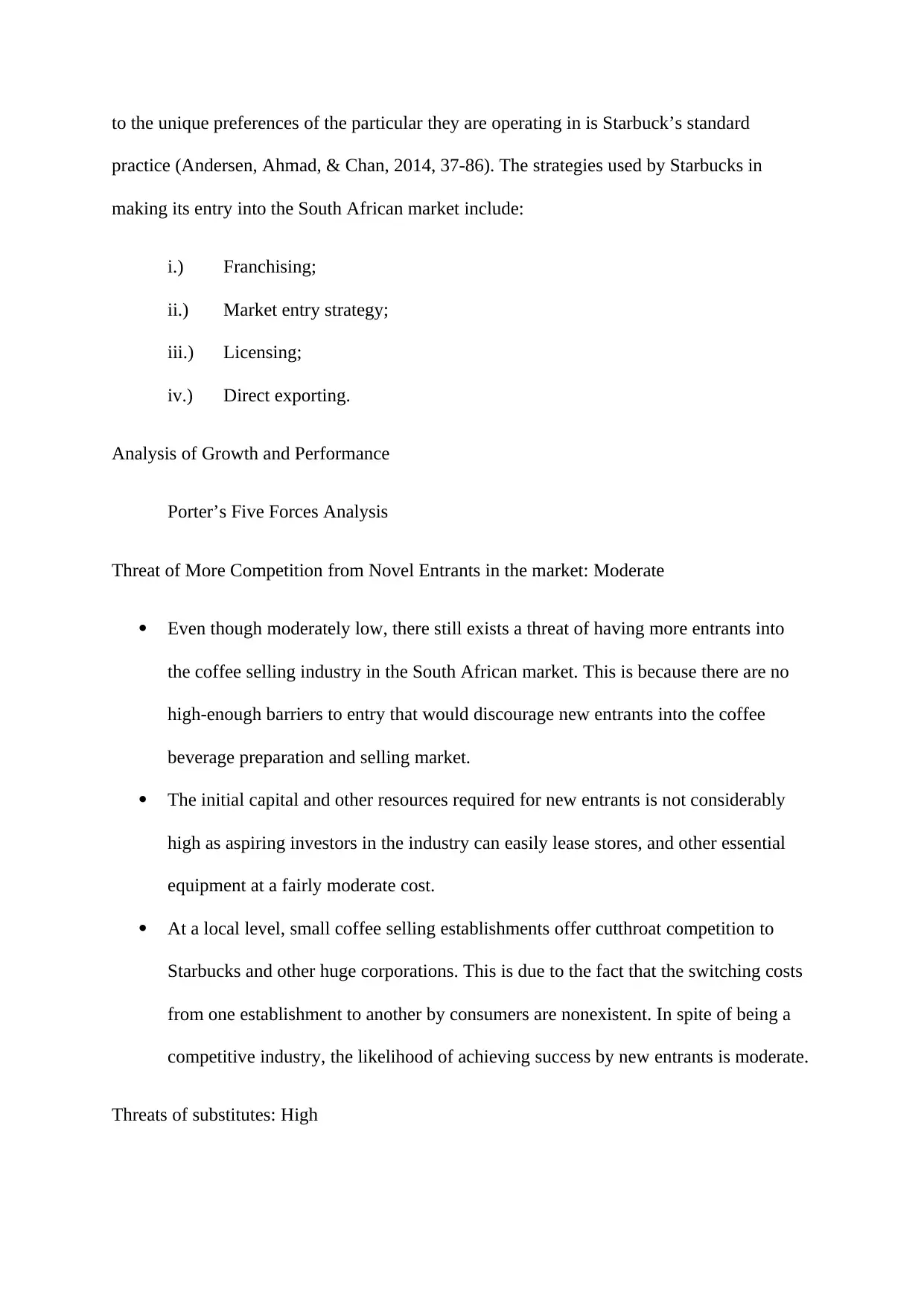
to the unique preferences of the particular they are operating in is Starbuck’s standard
practice (Andersen, Ahmad, & Chan, 2014, 37-86). The strategies used by Starbucks in
making its entry into the South African market include:
i.) Franchising;
ii.) Market entry strategy;
iii.) Licensing;
iv.) Direct exporting.
Analysis of Growth and Performance
Porter’s Five Forces Analysis
Threat of More Competition from Novel Entrants in the market: Moderate
Even though moderately low, there still exists a threat of having more entrants into
the coffee selling industry in the South African market. This is because there are no
high-enough barriers to entry that would discourage new entrants into the coffee
beverage preparation and selling market.
The initial capital and other resources required for new entrants is not considerably
high as aspiring investors in the industry can easily lease stores, and other essential
equipment at a fairly moderate cost.
At a local level, small coffee selling establishments offer cutthroat competition to
Starbucks and other huge corporations. This is due to the fact that the switching costs
from one establishment to another by consumers are nonexistent. In spite of being a
competitive industry, the likelihood of achieving success by new entrants is moderate.
Threats of substitutes: High
practice (Andersen, Ahmad, & Chan, 2014, 37-86). The strategies used by Starbucks in
making its entry into the South African market include:
i.) Franchising;
ii.) Market entry strategy;
iii.) Licensing;
iv.) Direct exporting.
Analysis of Growth and Performance
Porter’s Five Forces Analysis
Threat of More Competition from Novel Entrants in the market: Moderate
Even though moderately low, there still exists a threat of having more entrants into
the coffee selling industry in the South African market. This is because there are no
high-enough barriers to entry that would discourage new entrants into the coffee
beverage preparation and selling market.
The initial capital and other resources required for new entrants is not considerably
high as aspiring investors in the industry can easily lease stores, and other essential
equipment at a fairly moderate cost.
At a local level, small coffee selling establishments offer cutthroat competition to
Starbucks and other huge corporations. This is due to the fact that the switching costs
from one establishment to another by consumers are nonexistent. In spite of being a
competitive industry, the likelihood of achieving success by new entrants is moderate.
Threats of substitutes: High
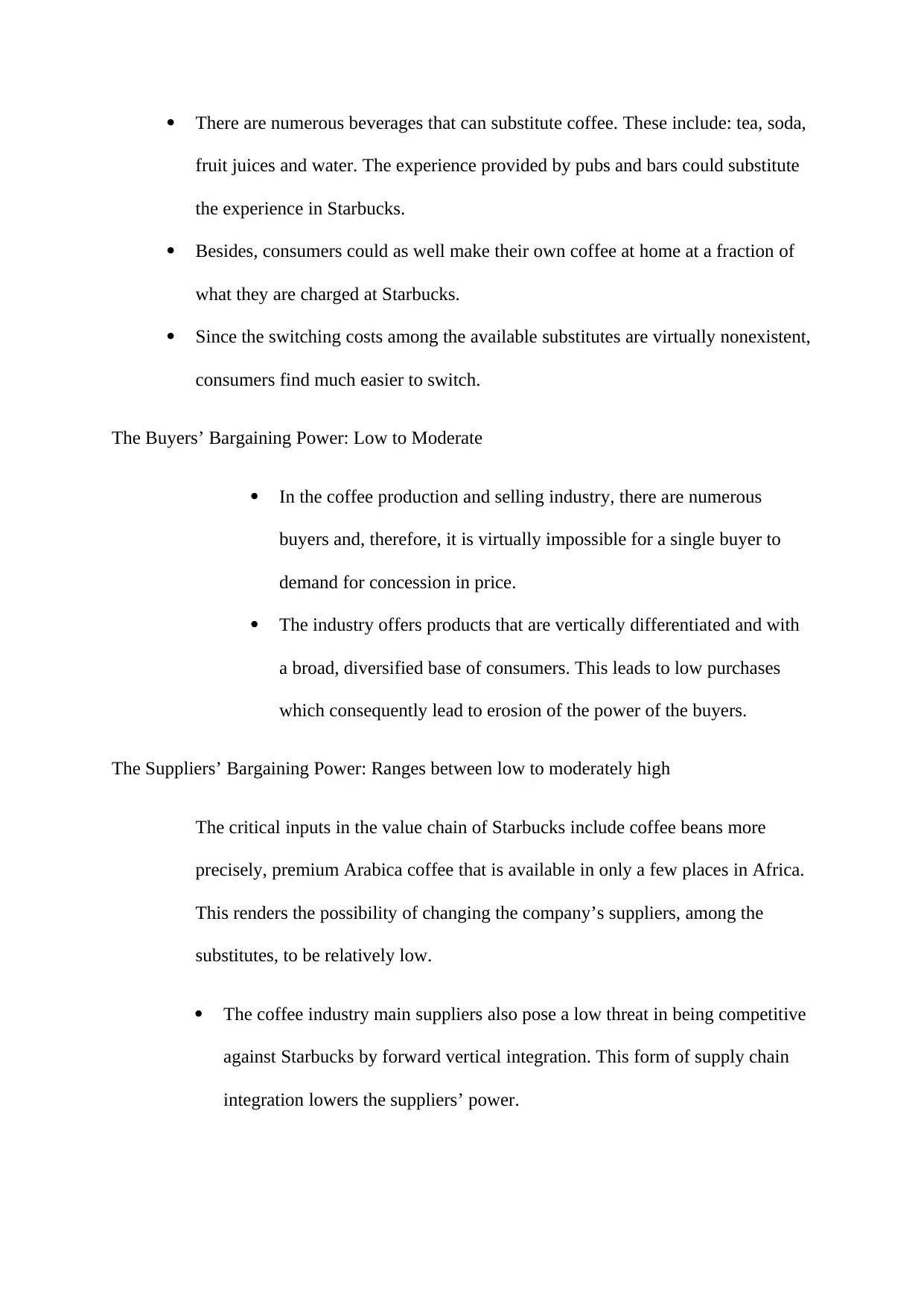
There are numerous beverages that can substitute coffee. These include: tea, soda,
fruit juices and water. The experience provided by pubs and bars could substitute
the experience in Starbucks.
Besides, consumers could as well make their own coffee at home at a fraction of
what they are charged at Starbucks.
Since the switching costs among the available substitutes are virtually nonexistent,
consumers find much easier to switch.
The Buyers’ Bargaining Power: Low to Moderate
In the coffee production and selling industry, there are numerous
buyers and, therefore, it is virtually impossible for a single buyer to
demand for concession in price.
The industry offers products that are vertically differentiated and with
a broad, diversified base of consumers. This leads to low purchases
which consequently lead to erosion of the power of the buyers.
The Suppliers’ Bargaining Power: Ranges between low to moderately high
The critical inputs in the value chain of Starbucks include coffee beans more
precisely, premium Arabica coffee that is available in only a few places in Africa.
This renders the possibility of changing the company’s suppliers, among the
substitutes, to be relatively low.
The coffee industry main suppliers also pose a low threat in being competitive
against Starbucks by forward vertical integration. This form of supply chain
integration lowers the suppliers’ power.
fruit juices and water. The experience provided by pubs and bars could substitute
the experience in Starbucks.
Besides, consumers could as well make their own coffee at home at a fraction of
what they are charged at Starbucks.
Since the switching costs among the available substitutes are virtually nonexistent,
consumers find much easier to switch.
The Buyers’ Bargaining Power: Low to Moderate
In the coffee production and selling industry, there are numerous
buyers and, therefore, it is virtually impossible for a single buyer to
demand for concession in price.
The industry offers products that are vertically differentiated and with
a broad, diversified base of consumers. This leads to low purchases
which consequently lead to erosion of the power of the buyers.
The Suppliers’ Bargaining Power: Ranges between low to moderately high
The critical inputs in the value chain of Starbucks include coffee beans more
precisely, premium Arabica coffee that is available in only a few places in Africa.
This renders the possibility of changing the company’s suppliers, among the
substitutes, to be relatively low.
The coffee industry main suppliers also pose a low threat in being competitive
against Starbucks by forward vertical integration. This form of supply chain
integration lowers the suppliers’ power.
⊘ This is a preview!⊘
Do you want full access?
Subscribe today to unlock all pages.

Trusted by 1+ million students worldwide
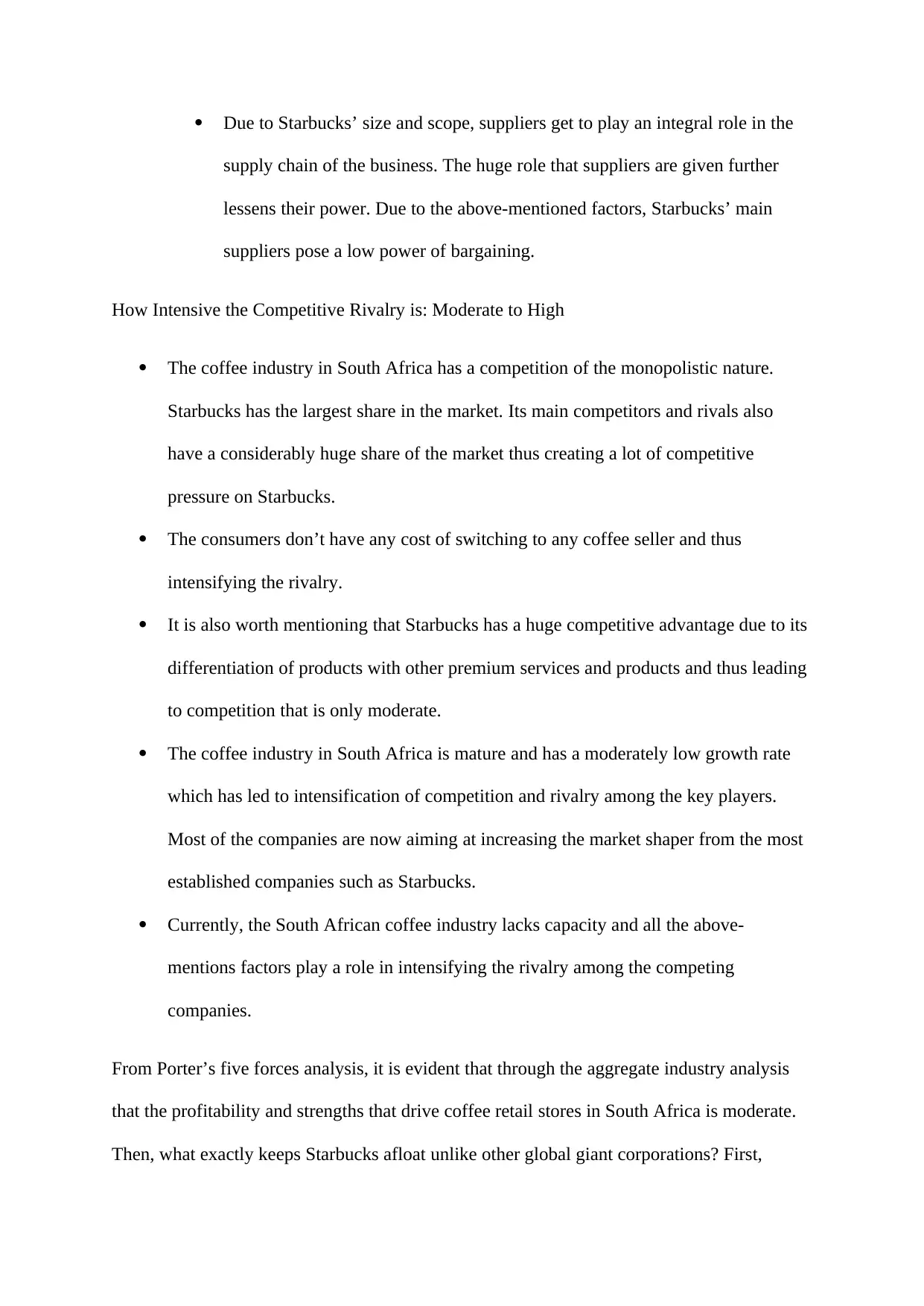
Due to Starbucks’ size and scope, suppliers get to play an integral role in the
supply chain of the business. The huge role that suppliers are given further
lessens their power. Due to the above-mentioned factors, Starbucks’ main
suppliers pose a low power of bargaining.
How Intensive the Competitive Rivalry is: Moderate to High
The coffee industry in South Africa has a competition of the monopolistic nature.
Starbucks has the largest share in the market. Its main competitors and rivals also
have a considerably huge share of the market thus creating a lot of competitive
pressure on Starbucks.
The consumers don’t have any cost of switching to any coffee seller and thus
intensifying the rivalry.
It is also worth mentioning that Starbucks has a huge competitive advantage due to its
differentiation of products with other premium services and products and thus leading
to competition that is only moderate.
The coffee industry in South Africa is mature and has a moderately low growth rate
which has led to intensification of competition and rivalry among the key players.
Most of the companies are now aiming at increasing the market shaper from the most
established companies such as Starbucks.
Currently, the South African coffee industry lacks capacity and all the above-
mentions factors play a role in intensifying the rivalry among the competing
companies.
From Porter’s five forces analysis, it is evident that through the aggregate industry analysis
that the profitability and strengths that drive coffee retail stores in South Africa is moderate.
Then, what exactly keeps Starbucks afloat unlike other global giant corporations? First,
supply chain of the business. The huge role that suppliers are given further
lessens their power. Due to the above-mentioned factors, Starbucks’ main
suppliers pose a low power of bargaining.
How Intensive the Competitive Rivalry is: Moderate to High
The coffee industry in South Africa has a competition of the monopolistic nature.
Starbucks has the largest share in the market. Its main competitors and rivals also
have a considerably huge share of the market thus creating a lot of competitive
pressure on Starbucks.
The consumers don’t have any cost of switching to any coffee seller and thus
intensifying the rivalry.
It is also worth mentioning that Starbucks has a huge competitive advantage due to its
differentiation of products with other premium services and products and thus leading
to competition that is only moderate.
The coffee industry in South Africa is mature and has a moderately low growth rate
which has led to intensification of competition and rivalry among the key players.
Most of the companies are now aiming at increasing the market shaper from the most
established companies such as Starbucks.
Currently, the South African coffee industry lacks capacity and all the above-
mentions factors play a role in intensifying the rivalry among the competing
companies.
From Porter’s five forces analysis, it is evident that through the aggregate industry analysis
that the profitability and strengths that drive coffee retail stores in South Africa is moderate.
Then, what exactly keeps Starbucks afloat unlike other global giant corporations? First,
Paraphrase This Document
Need a fresh take? Get an instant paraphrase of this document with our AI Paraphraser

Starbucks has a large scope and scale that offers it a huge competitive advantage and easy
access to raw materials due to the relationship that it builds with its suppliers (Keith, 2006).
Starbucks also leverages on its brand equity, massive resources and prime locations of their
real estate to net customers (Zekiri & Angelova, 2011, pp. 572-584).
Additionally, Starbucks counters the existent threat of substitutes through selling coffee
makers and premium coffee packs in grocery stores. Most importantly, Starbucks maintains
fair trade with its suppliers. With its huge scale and size, Starbucks has the power to easily
take advantage and exploit its suppliers (Gioeli, 2014). However, the global giant chooses to
maintain a fair trade thus giving its suppliers fair partnership status.
Q.3.Conclusion
Opportunities for Expansion in other African Markets in Future
Going forward, how would Starbucks continue to use its scale and size in growing its
business in the turbulent African market? Currently and in the future, there are more
opportunities that could propel Starbucks’ expansion into the rest of the African market.
There is an increasing preference for coffee in Africa. Starbucks, which has already
established its brand as the finest coffee maker and seller can easily make its entry into the
rest of the African market. The increase in the demand for specialty coffee offers Starbucks a
great opportunity to expand its operations in the African market. From the analysis of more
emergent and possible opportunities in the African market such as increased spending and
constantly growing middle class, Starbucks has a higher likelihood of successfully venturing
into the rest of the African market (Fabling, & Sanderson, 2013).
Challenges of Conquering the African Market in the Long Run
access to raw materials due to the relationship that it builds with its suppliers (Keith, 2006).
Starbucks also leverages on its brand equity, massive resources and prime locations of their
real estate to net customers (Zekiri & Angelova, 2011, pp. 572-584).
Additionally, Starbucks counters the existent threat of substitutes through selling coffee
makers and premium coffee packs in grocery stores. Most importantly, Starbucks maintains
fair trade with its suppliers. With its huge scale and size, Starbucks has the power to easily
take advantage and exploit its suppliers (Gioeli, 2014). However, the global giant chooses to
maintain a fair trade thus giving its suppliers fair partnership status.
Q.3.Conclusion
Opportunities for Expansion in other African Markets in Future
Going forward, how would Starbucks continue to use its scale and size in growing its
business in the turbulent African market? Currently and in the future, there are more
opportunities that could propel Starbucks’ expansion into the rest of the African market.
There is an increasing preference for coffee in Africa. Starbucks, which has already
established its brand as the finest coffee maker and seller can easily make its entry into the
rest of the African market. The increase in the demand for specialty coffee offers Starbucks a
great opportunity to expand its operations in the African market. From the analysis of more
emergent and possible opportunities in the African market such as increased spending and
constantly growing middle class, Starbucks has a higher likelihood of successfully venturing
into the rest of the African market (Fabling, & Sanderson, 2013).
Challenges of Conquering the African Market in the Long Run
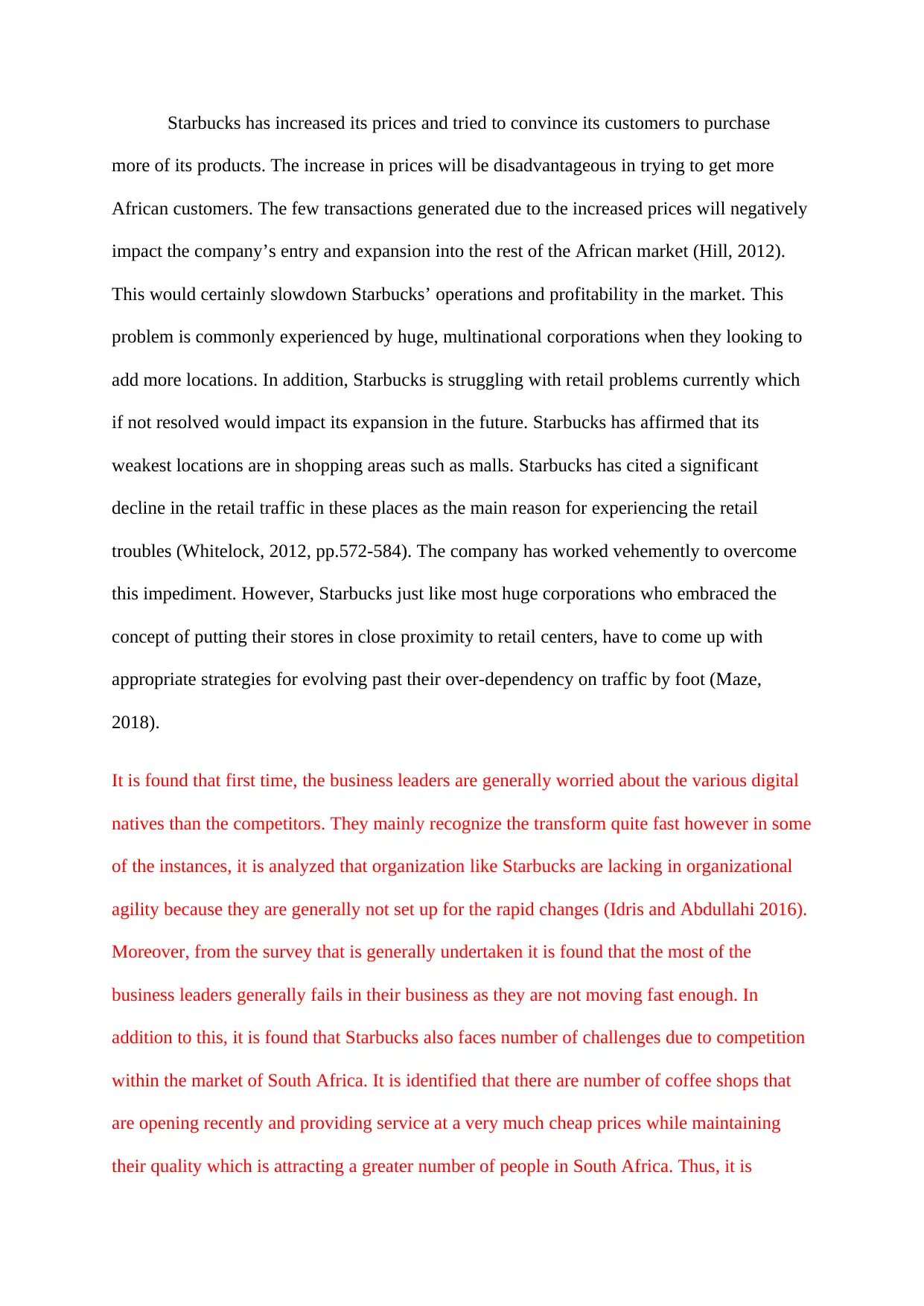
Starbucks has increased its prices and tried to convince its customers to purchase
more of its products. The increase in prices will be disadvantageous in trying to get more
African customers. The few transactions generated due to the increased prices will negatively
impact the company’s entry and expansion into the rest of the African market (Hill, 2012).
This would certainly slowdown Starbucks’ operations and profitability in the market. This
problem is commonly experienced by huge, multinational corporations when they looking to
add more locations. In addition, Starbucks is struggling with retail problems currently which
if not resolved would impact its expansion in the future. Starbucks has affirmed that its
weakest locations are in shopping areas such as malls. Starbucks has cited a significant
decline in the retail traffic in these places as the main reason for experiencing the retail
troubles (Whitelock, 2012, pp.572-584). The company has worked vehemently to overcome
this impediment. However, Starbucks just like most huge corporations who embraced the
concept of putting their stores in close proximity to retail centers, have to come up with
appropriate strategies for evolving past their over-dependency on traffic by foot (Maze,
2018).
It is found that first time, the business leaders are generally worried about the various digital
natives than the competitors. They mainly recognize the transform quite fast however in some
of the instances, it is analyzed that organization like Starbucks are lacking in organizational
agility because they are generally not set up for the rapid changes (Idris and Abdullahi 2016).
Moreover, from the survey that is generally undertaken it is found that the most of the
business leaders generally fails in their business as they are not moving fast enough. In
addition to this, it is found that Starbucks also faces number of challenges due to competition
within the market of South Africa. It is identified that there are number of coffee shops that
are opening recently and providing service at a very much cheap prices while maintaining
their quality which is attracting a greater number of people in South Africa. Thus, it is
more of its products. The increase in prices will be disadvantageous in trying to get more
African customers. The few transactions generated due to the increased prices will negatively
impact the company’s entry and expansion into the rest of the African market (Hill, 2012).
This would certainly slowdown Starbucks’ operations and profitability in the market. This
problem is commonly experienced by huge, multinational corporations when they looking to
add more locations. In addition, Starbucks is struggling with retail problems currently which
if not resolved would impact its expansion in the future. Starbucks has affirmed that its
weakest locations are in shopping areas such as malls. Starbucks has cited a significant
decline in the retail traffic in these places as the main reason for experiencing the retail
troubles (Whitelock, 2012, pp.572-584). The company has worked vehemently to overcome
this impediment. However, Starbucks just like most huge corporations who embraced the
concept of putting their stores in close proximity to retail centers, have to come up with
appropriate strategies for evolving past their over-dependency on traffic by foot (Maze,
2018).
It is found that first time, the business leaders are generally worried about the various digital
natives than the competitors. They mainly recognize the transform quite fast however in some
of the instances, it is analyzed that organization like Starbucks are lacking in organizational
agility because they are generally not set up for the rapid changes (Idris and Abdullahi 2016).
Moreover, from the survey that is generally undertaken it is found that the most of the
business leaders generally fails in their business as they are not moving fast enough. In
addition to this, it is found that Starbucks also faces number of challenges due to competition
within the market of South Africa. It is identified that there are number of coffee shops that
are opening recently and providing service at a very much cheap prices while maintaining
their quality which is attracting a greater number of people in South Africa. Thus, it is
⊘ This is a preview!⊘
Do you want full access?
Subscribe today to unlock all pages.

Trusted by 1+ million students worldwide

analyzed that the high prices of food items as well as beverages in South Africa is considered
as one of the major challenges in conquering the market by Starbucks.
VUCA analysis
VUCA is an acronym that mainly stands for volatility, uncertainty, complexity as well as
ambiguity which are considered as the combination of various qualities that helps in
characterizing the nature of some of the difficult situations as well as conditions.
Volatility: Volatility is considered as the quality that is being subject to rapid, significant as
well as frequent changes (Sucharita 2016). It is found that within a volatile market, the prices
of Coffee can rise or fall considerably within a short period of time and the direction of a
trend can generally reverse suddenly.
Uncertainty: It is defined as one of the important components of a situation in which the
events as well as outcomes are very much unpredictable. It is found that uncertainty mainly
occurs due to some of the important characteristics like inappropriate knowledge about the
cause and effect of the situation (Elkington et al. 2017). Moreover, it is found that uncertainty
is seen within the business approaches of the organization that generally enhances the
business intelligence related activities including collecting, interpreting as well as sharing
important information.
Complexity: Complexity generally involves a multiplicity of number of issues as well as
factors in which some of them are intricately interconnected. Complexity variables are
considered as the easiest among the four factors but the managers are not able to know about
the factors about which they do not know which further enhances the complexity of the
situation. It is found that managers generally like the outcomes but they are not the
unintended consequences.
as one of the major challenges in conquering the market by Starbucks.
VUCA analysis
VUCA is an acronym that mainly stands for volatility, uncertainty, complexity as well as
ambiguity which are considered as the combination of various qualities that helps in
characterizing the nature of some of the difficult situations as well as conditions.
Volatility: Volatility is considered as the quality that is being subject to rapid, significant as
well as frequent changes (Sucharita 2016). It is found that within a volatile market, the prices
of Coffee can rise or fall considerably within a short period of time and the direction of a
trend can generally reverse suddenly.
Uncertainty: It is defined as one of the important components of a situation in which the
events as well as outcomes are very much unpredictable. It is found that uncertainty mainly
occurs due to some of the important characteristics like inappropriate knowledge about the
cause and effect of the situation (Elkington et al. 2017). Moreover, it is found that uncertainty
is seen within the business approaches of the organization that generally enhances the
business intelligence related activities including collecting, interpreting as well as sharing
important information.
Complexity: Complexity generally involves a multiplicity of number of issues as well as
factors in which some of them are intricately interconnected. Complexity variables are
considered as the easiest among the four factors but the managers are not able to know about
the factors about which they do not know which further enhances the complexity of the
situation. It is found that managers generally like the outcomes but they are not the
unintended consequences.
Paraphrase This Document
Need a fresh take? Get an instant paraphrase of this document with our AI Paraphraser

Ambiguity: Ambiguity is generally manifested in the difficulty of understanding the
situation. The main characteristics of ambiguity is that the casual relationship is completely
unclear and therefore the companies need to prepare about the risks as well as challenges for
evaluating the outcomes (Chawla and Lenka 2017).
situation. The main characteristics of ambiguity is that the casual relationship is completely
unclear and therefore the companies need to prepare about the risks as well as challenges for
evaluating the outcomes (Chawla and Lenka 2017).
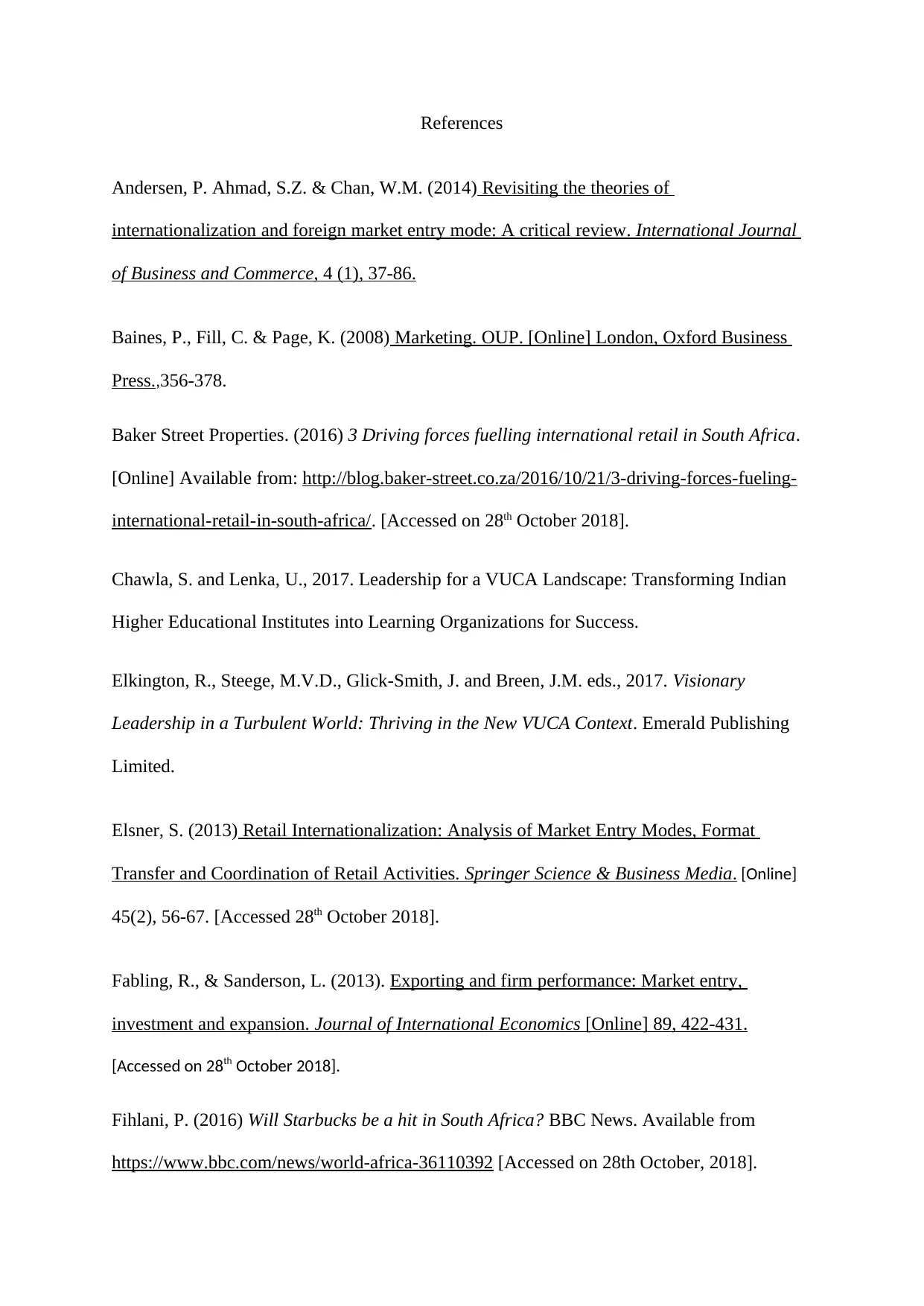
References
Andersen, P. Ahmad, S.Z. & Chan, W.M. (2014) Revisiting the theories of
internationalization and foreign market entry mode: A critical review. International Journal
of Business and Commerce, 4 (1), 37-86.
Baines, P., Fill, C. & Page, K. (2008) Marketing. OUP. [Online] London, Oxford Business
Press.,356-378.
Baker Street Properties. (2016) 3 Driving forces fuelling international retail in South Africa.
[Online] Available from: http://blog.baker-street.co.za/2016/10/21/3-driving-forces-fueling-
international-retail-in-south-africa/. [Accessed on 28th October 2018].
Chawla, S. and Lenka, U., 2017. Leadership for a VUCA Landscape: Transforming Indian
Higher Educational Institutes into Learning Organizations for Success.
Elkington, R., Steege, M.V.D., Glick-Smith, J. and Breen, J.M. eds., 2017. Visionary
Leadership in a Turbulent World: Thriving in the New VUCA Context. Emerald Publishing
Limited.
Elsner, S. (2013) Retail Internationalization: Analysis of Market Entry Modes, Format
Transfer and Coordination of Retail Activities. Springer Science & Business Media. [Online]
45(2), 56-67. [Accessed 28th October 2018].
Fabling, R., & Sanderson, L. (2013). Exporting and firm performance: Market entry,
investment and expansion. Journal of International Economics [Online] 89, 422-431.
[Accessed on 28th October 2018].
Fihlani, P. (2016) Will Starbucks be a hit in South Africa? BBC News. Available from
https://www.bbc.com/news/world-africa-36110392 [Accessed on 28th October, 2018].
Andersen, P. Ahmad, S.Z. & Chan, W.M. (2014) Revisiting the theories of
internationalization and foreign market entry mode: A critical review. International Journal
of Business and Commerce, 4 (1), 37-86.
Baines, P., Fill, C. & Page, K. (2008) Marketing. OUP. [Online] London, Oxford Business
Press.,356-378.
Baker Street Properties. (2016) 3 Driving forces fuelling international retail in South Africa.
[Online] Available from: http://blog.baker-street.co.za/2016/10/21/3-driving-forces-fueling-
international-retail-in-south-africa/. [Accessed on 28th October 2018].
Chawla, S. and Lenka, U., 2017. Leadership for a VUCA Landscape: Transforming Indian
Higher Educational Institutes into Learning Organizations for Success.
Elkington, R., Steege, M.V.D., Glick-Smith, J. and Breen, J.M. eds., 2017. Visionary
Leadership in a Turbulent World: Thriving in the New VUCA Context. Emerald Publishing
Limited.
Elsner, S. (2013) Retail Internationalization: Analysis of Market Entry Modes, Format
Transfer and Coordination of Retail Activities. Springer Science & Business Media. [Online]
45(2), 56-67. [Accessed 28th October 2018].
Fabling, R., & Sanderson, L. (2013). Exporting and firm performance: Market entry,
investment and expansion. Journal of International Economics [Online] 89, 422-431.
[Accessed on 28th October 2018].
Fihlani, P. (2016) Will Starbucks be a hit in South Africa? BBC News. Available from
https://www.bbc.com/news/world-africa-36110392 [Accessed on 28th October, 2018].
⊘ This is a preview!⊘
Do you want full access?
Subscribe today to unlock all pages.

Trusted by 1+ million students worldwide
1 out of 14
Your All-in-One AI-Powered Toolkit for Academic Success.
+13062052269
info@desklib.com
Available 24*7 on WhatsApp / Email
![[object Object]](/_next/static/media/star-bottom.7253800d.svg)
Unlock your academic potential
Copyright © 2020–2025 A2Z Services. All Rights Reserved. Developed and managed by ZUCOL.
